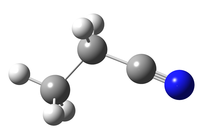|
NOTE: The v12
= 1 state at 769 K is the seventh excited state of ethyl cyanide.
Even tough it is relatively isolated, there may be transitions which
show methyl internal rotation splitting, especially b-type
transitions. The current entry only deals with the A symmetry
species and may thus account for half of the intensity if the
modeling is focused on the weak, here split, transitions.
The methyl internal rotation splitting appears to be rarer
than for v20 = 1. Some transitions appear
to be perturbed, especially at higher J or Ka,
and these perturbations appear to be more prevalent than for
v20 = 1.
The observed transitions were summarized by
(1) A. M. Daly, C. Bermúdez, A. López, B. Tercero,
J. C. Pearson, N. Marcelino, J. L. Alonso, and J. Cernicharo,
2013, Astrophys. J. 768, Art. No. 81.
Besides new spectral recordings, data were extracted from
spectra published by
(2) J. C. Pearson, K. V. L. N. Sastry, E. Herbst,
and F. C. De Lucia,
1994, Astrophys. J. Suppl. Ser. 93, 589;
from
(3) Y. Fukuyama, H. Odashima, K. Takagi, S. Tsunekawa,
1996, Astrophys. J. Suppl. Ser. 104, 329;
from
(4) C. S. Brauer, J. C. Pearson, B. J. Drouin, and S. Yu,
2009, Astrophys. J. Suppl. Ser. 184, 133;
and from
(5) S. M. Fortman, I. R. Medvedev, C. F. Neese, and F. C. De Lucia,
2010, Astrophys. J. 725, 1682.
NOTE: The spectroscopic
parameters are different from those in (1). Several more higher
J or Ka transitions were weighted
out than in (1) for consistency reason. Perturbations,
blending, or possibly misassignments may cause deviations
from calculated positions several times (usually four)
larger than assigned. Some high J, low Ka
transitions weighted out in (1) were weighted in here.
Please check the output of the
fit file for transitions having the same Ka
and a similar J in case of issues with one of not too
many problematic lines. Extrapolation may be possible to
slightly higher J for lower values of Ka,
but should always be viewed with caution. Only fully weighted
transitions have been merged.
NOTE: The partition function
takes into account energy levels up to J = 150 and
Ka = 70. This is sufficient up to 300 K.
At higher temperatures classical extrapolations are recommended.
Already somewhat below 200 K it may be necessary to correct
the partition function values for contributions from
low-lying vibrational modes.
Vibrational correction factors have been derived
in the harmonic approximation. Errors caused by this
approximation are probably small.
The ground state dipole moment was taken from
(9) A. Krasnicki and Z. Kisiel,
2011, J. Mol. Spectrosc. 270, 83.
|
